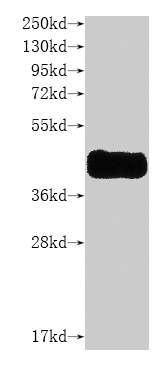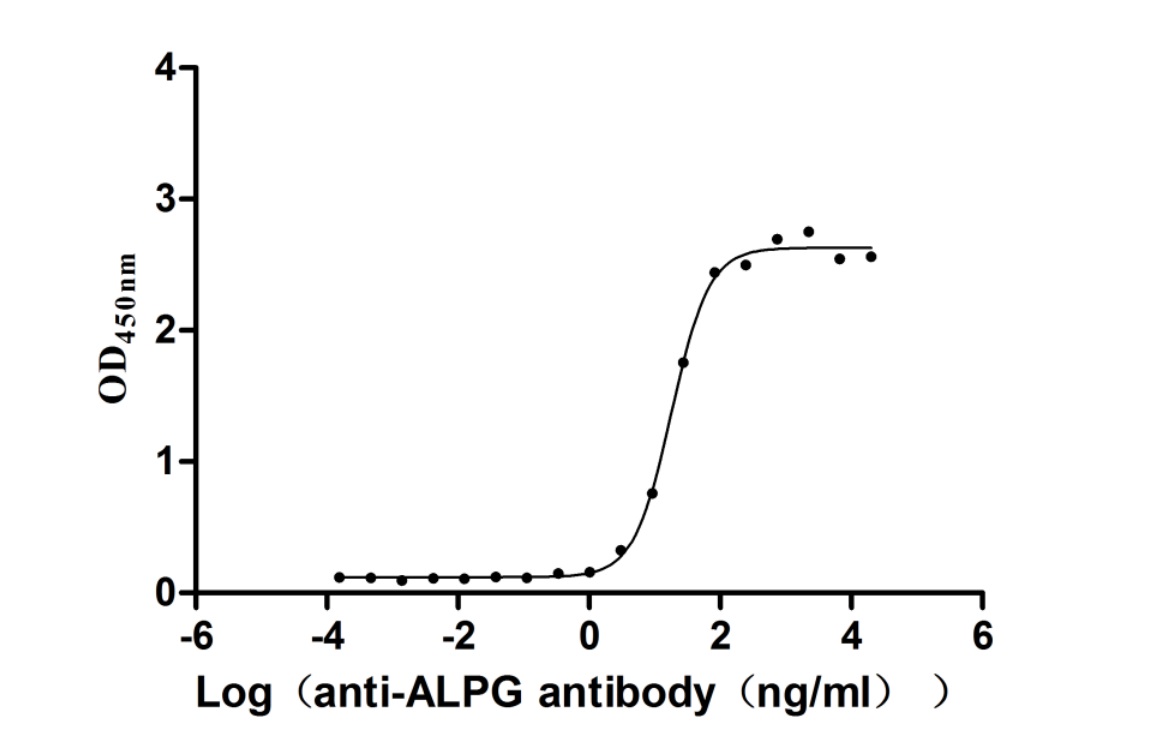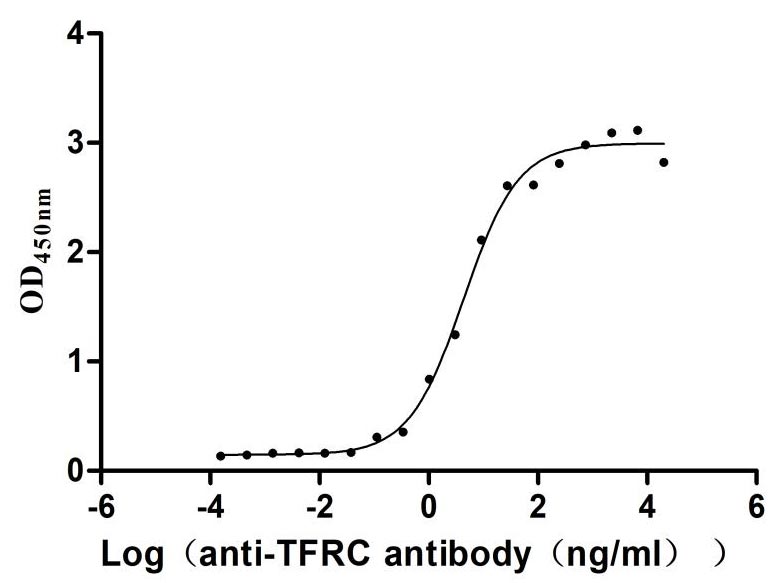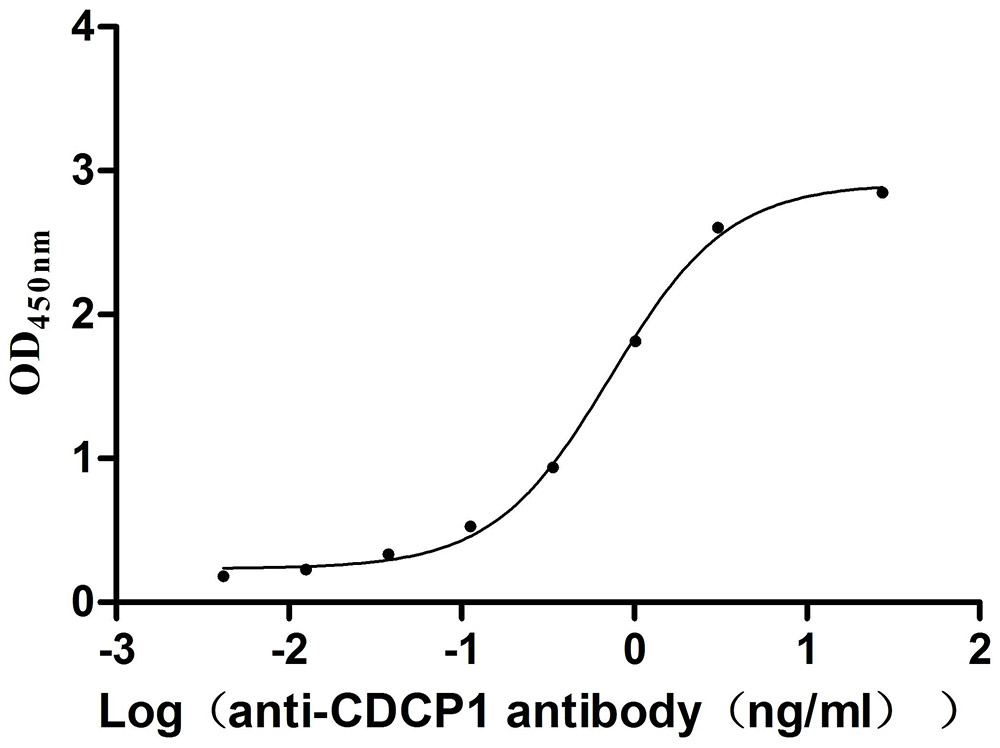Recombinant Mouse Taste receptor type 1 member 3 (Tas1r3), partial
-
中文名称:小鼠Tas1r3重组蛋白
-
货号:CSB-YP835679MO
-
规格:
-
来源:Yeast
-
其他:
-
中文名称:小鼠Tas1r3重组蛋白
-
货号:CSB-EP835679MO
-
规格:
-
来源:E.coli
-
其他:
-
中文名称:小鼠Tas1r3重组蛋白
-
货号:CSB-EP835679MO-B
-
规格:
-
来源:E.coli
-
共轭:Avi-tag Biotinylated
E. coli biotin ligase (BirA) is highly specific in covalently attaching biotin to the 15 amino acid AviTag peptide. This recombinant protein was biotinylated in vivo by AviTag-BirA technology, which method is BriA catalyzes amide linkage between the biotin and the specific lysine of the AviTag.
-
其他:
-
中文名称:小鼠Tas1r3重组蛋白
-
货号:CSB-BP835679MO
-
规格:
-
来源:Baculovirus
-
其他:
-
中文名称:小鼠Tas1r3重组蛋白
-
货号:CSB-MP835679MO
-
规格:
-
来源:Mammalian cell
-
其他:
产品详情
-
纯度:>85% (SDS-PAGE)
-
基因名:
-
Uniprot No.:
-
别名:Tas1r3; Sac; T1r3; Tr3; Taste receptor type 1 member 3; Saccharin preference protein; Sweet taste receptor T1R3
-
种属:Mus musculus (Mouse)
-
蛋白长度:Partial
-
蛋白标签:Tag type will be determined during the manufacturing process.
The tag type will be determined during production process. If you have specified tag type, please tell us and we will develop the specified tag preferentially. -
产品提供形式:Lyophilized powder
Note: We will preferentially ship the format that we have in stock, however, if you have any special requirement for the format, please remark your requirement when placing the order, we will prepare according to your demand. -
复溶:We recommend that this vial be briefly centrifuged prior to opening to bring the contents to the bottom. Please reconstitute protein in deionized sterile water to a concentration of 0.1-1.0 mg/mL.We recommend to add 5-50% of glycerol (final concentration) and aliquot for long-term storage at -20℃/-80℃. Our default final concentration of glycerol is 50%. Customers could use it as reference.
-
储存条件:Store at -20°C/-80°C upon receipt, aliquoting is necessary for mutiple use. Avoid repeated freeze-thaw cycles.
-
保质期:The shelf life is related to many factors, storage state, buffer ingredients, storage temperature and the stability of the protein itself.
Generally, the shelf life of liquid form is 6 months at -20°C/-80°C. The shelf life of lyophilized form is 12 months at -20°C/-80°C. -
货期:Delivery time may differ from different purchasing way or location, please kindly consult your local distributors for specific delivery time.Note: All of our proteins are default shipped with normal blue ice packs, if you request to ship with dry ice, please communicate with us in advance and extra fees will be charged.
-
注意事项:Repeated freezing and thawing is not recommended. Store working aliquots at 4°C for up to one week.
-
Datasheet :Please contact us to get it.
靶点详情
-
功能:Putative taste receptor. TAS1R1/TAS1R3 responds to the umami taste stimulus (the taste of monosodium glutamate) and also to most of the 20 standard L-amino acids, but not to their D-enantiomers or other compounds. TAS1R2/TAS1R3 recognizes diverse natural and synthetic sweeteners. TAS1R3 is essential for the recognition and response to the disaccharide trehalose. Sequence differences within and between species can significantly influence the selectivity and specificity of taste responses.
-
基因功能参考文献:
- T1R3-mediated visceral reception of metabolites is involved in control of carbohydrate and lipid metabolism. PMID: 30192493
- T1R1/T1R3 modulates the mTOR pathway to regulate milk protein synthesis in the mouse mammary gland in vivo. PMID: 28497545
- Data, including data from studies with mutant and knockout mice, suggest that Tas1R3 and Tas1R2 are expressed endogenously in osteoclast stem cells; their expression levels parallel robust increase in osteoclast biomarker Ctsk during osteoclast differentiation. Tas1R3 is expressed in undifferentiated bone marrow stromal cells and its expression is maintained during osteogenic differentiation. (Ctsk = cathepsin K) PMID: 29019082
- results suggest that the T1R3 homomeric sweet taste receptor negatively regulates adipogenesis through Galphas-mediated microtubule disassembly and consequent activation of the Rho/ROCK pathway. PMID: 28472098
- T1r3 was upregulated in the adipose tissue of wild type mice in response to high fat/low carbohydrate diet, and their expression positively correlated with fat mass and glucose intolerance. PMID: 26884387
- T1R3 and alpha-gustducin exhibited a stage-dependent expression pattern during mouse development, and a cell-specific pattern during the spermatogenic cycle. PMID: 26589384
- Low concentration of endogenous GC is necessary and sufficient for induction of T1R3 expression. Higher concentrations may inhibit such induction. This inhibitory effect may be due, at least in part, to a direct action of GC on taste cells. PMID: 26096555
- T1R1/T1R3 have roles in regulating ERK1/2 and mTORC1 in MIN6 cells PMID: 26168033
- Taken together, our study raises the possibility that MyoD and Myogenin might control skeletal muscle metabolism and homeostasis through the regulation of T1R3 promoter activity. PMID: 26545778
- Mice lacking the Tas1r3 taste receptor gene display impaired glucose metabolism. PMID: 26107521
- Involvement of multiple taste receptors in umami taste: analysis of gustatory nerve responses in metabotropic glutamate receptor 4 knockout mice PMID: 25529865
- T1R3 is expressed mainly in beta-cells and the expression levels are different depending upon the nutritional and metabolic conditions. PMID: 24898279
- In the Tas1r3-/- strain, in addition to disappearance of taste preference for sucrose, glucose tolerance is also substantially reduced, and insulin resistance is observed. PMID: 25775865
- These data implicate the T1r3 receptor in the sensory detection and transduction of ethanol taste. PMID: 20145204
- This study demonistrated that the Tlr3 knockot mice consumed only half as much sugar per day as did Wild type mice. PMID: 24384370
- The results confirm the sweet taste deficits of T1r3 KO mice but demonstrate their ability to develop strong glucose and milder galactose preferences attributed to the postoral actions of these sugars. PMID: 23547138
- T1R3 and mGluR5 regulate intestinal epithelial cells in a mouse model of total parenteral nutrition PMID: 24497581
- A complex molecular mechanism involving changes in the properties of both the orthosteric and non-orthosteric sites of T1R1 underlies the determination of ligand specificity in mammalian T1R1/T1R3. PMID: 24214976
- speculate that TAS1R3 and GNAT3 activators may help infertile men, particularly those that are affected by some of the mentioned inhibitors and/or are diagnosed with idiopathic infertility involving signaling pathway of these receptors PMID: 23818598
- cell surface G protein coupled receptor (GPCR) TAS1R1-TAS1R3 (T1R1-T1R3) can sense extracellular amino acids, activate MTORC1, and inhibit autophagy PMID: 23222068
- The findings of this study indicated that T1r3 and Trpm5 play critical roles in carbohydrate-induced dietary obesity. PMID: 22683548
- findings show that T1R1/T1R3 is an early sensor of amino acid availability; reduced expression of this receptor impairs activation of mTORC1 by amino acids, results in mTORC1 mislocalization, and accelerates autophagy PMID: 22959271
- examined the function of umami taste receptor, which has a dimeric protein structure composed of Tas1r1 and Tas1r3, as an amino acid sensor PMID: 22189795
- Data show that that Tas1r1 and Tas1r3 are expressed in murine and human spermatozoa. PMID: 22427794
- Data suggest that the absence of intestinal microbiota alters expression of (i.e., up-regulates) Tas1r3 and Sglt1 in proximal small intestine, factors associated with increased consumption of nutritive sweet solutions. PMID: 21781379
- Data sugget that heterodimer of Tas1R1 and Tas1R3 is the fundamental receptor for the sensing amino acids and regulates the amino acid-induced insulin secretion in pancreatic beta-cells. PMID: 21470345
- Results sugest that K(ATP) channels constitute a major portion of K(+) channels in the T1r3 subset of taste cells. PMID: 21383163
- These findings provide clear evidence that gut T1R3 receptors are not necessary for sugar-conditioned flavor preferences or sucralose-induced flavor avoidance in mice. PMID: 20926763
- In mice Tas1r3 genotype does not predict sugar-induced hyperphagia or obesity; sucrose solutions stimulate higher daily intakes than isocaloric fructose; and susceptibility to sugar-induced obesity varies with strain, sugar concentration and sugar type. PMID: 20600198
- Data show that the absence of Tas1R3 or presence of the non-taster allele in mice predetermines rejection of alcohol. PMID: 20665148
- The expression of the T1R subtype T1R3, which is essential for the detection of both sugars and amino acids in the gustatory system, in two distinct cell populations of the gastric mucosa, is demonstrated. PMID: 20063013
- T1R1 and T1R3 combine to function as a broadly tuned L-amino-acid sensor responding to most of the 20 standard amino acids, but not to their D-enantiomers or other compounds PMID: 11894099
- mice lacking T1r3 showed no preference for artificial sweeteners and had diminished but not abolished behavioral and nerve responses to sugars and umami compounds PMID: 12869700
- Results show that the candidate sweet taste receptor T1R3 is essential for the recognition and response to the disaccharide trehalose. PMID: 12892531
- Polymorphisms associated with saccharin preference do not block gene expression, change alternative splicing, or interfere with protein translation in taste tissue. Ile60Thr may influence the ability of the protein to form dimers or bind sweeteners PMID: 14749438
- This study describes the range of ligand sensitivity of the T1R3 receptor using an in vivo approach and, to our knowledge, is the first genetic mapping study of activity in gustatory nerves PMID: 14999080
- cysteine-rich region of T1R3 has a role in determining responses to intensely sweet proteins PMID: 15299024
- An operant conditioning study of "taster" vs. "non-taster" mice was conducted to determine whether the phenotypes are due only to sensory sensitivity. PMID: 15337688
- Tas1r3 polymorphisms contribute to initial lick responsiveness to low but not high concentrations of sweeteners. PMID: 16135742
- describe in detail two strategies for the expression and purification of the ligand-binding domain of T1R taste receptors, which are constituents of the sweet and umami taste receptors PMID: 16621970
- Association between taste perception and alcohol intake, we used three different mutant mice, each lacking a gene expressed in taste buds and critical to taste transduction: alpha-gustducin (Gnat3), Tas1r3 or Trpm5. PMID: 17376151
- T1R3 functions as a gustatory calcium-magnesium receptor. PMID: 18593862
- The results rationalize artificial sweetener tastes and off-tastes by showing that at low concentrations, they stimulate the gustatory system through the T1R3 pathway, and at higher concentrations, their aversion is partly mediated by TRPV1. PMID: 18804451
- Data show that wheat germ agglutinin immunoreactivity is found in the geniculate and petrosal ganglia of transgenic mice. PMID: 18831764
- T1R3 taste receptor is critical for sucrose but not Polycose taste. PMID: 19091911
- Report the existence of multiple transduction pathways underlying responses to sugars: a T1R3-independent gurmarin sensitive pathway for sucrose and glucose. PMID: 19211717
- This study suggested that T1r3 receptors as primary contributors to the nucleus tractus solitarius sweet processing in mice. PMID: 19279151
显示更多
收起更多
-
亚细胞定位:Cell membrane; Multi-pass membrane protein.
-
蛋白家族:G-protein coupled receptor 3 family, TAS1R subfamily
-
组织特异性:Expressed in circumvallate, foliate and fungiform taste papillae as well as in taste buds on the palate. Also expressed in testis. Not expressed in brain, heart, kidney, liver or spleen. The topographic distribution in various taste papillae is different
-
数据库链接:
Most popular with customers
-
Recombinant Human CD276 antigen (CD276), partial (Active)
Express system: Mammalian cell
Species: Homo sapiens (Human)
-
Recombinant Human Tumor necrosis factor ligand superfamily member 9 (TNFSF9), partial (Active)
Express system: Mammalian cell
Species: Homo sapiens (Human)
-
Recombinant Human Tissue factor pathway inhibitor (TFPI), partial (Active)
Express system: Mammalian cell
Species: Homo sapiens (Human)
-
Recombinant Human Dickkopf-related protein 1 (DKK1) (Active)
Express system: Mammalian cell
Species: Homo sapiens (Human)
-
Recombinant Human C-C chemokine receptor type 8 (CCR8)-VLPs (Active)
Express system: Mammalian cell
Species: Homo sapiens (Human)
-
Recombinant Human Alkaline phosphatase, germ cell type (ALPG) (Active)
Express system: Mammalian cell
Species: Homo sapiens (Human)
-
Recombinant Human Transferrin receptor protein 1 (TFRC), partial (Active)
Express system: Mammalian cell
Species: Homo sapiens (Human)
-
Recombinant Mouse CUB domain-containing protein 1 (Cdcp1), partial (Active)
Express system: Mammalian cell
Species: Mus musculus (Mouse)




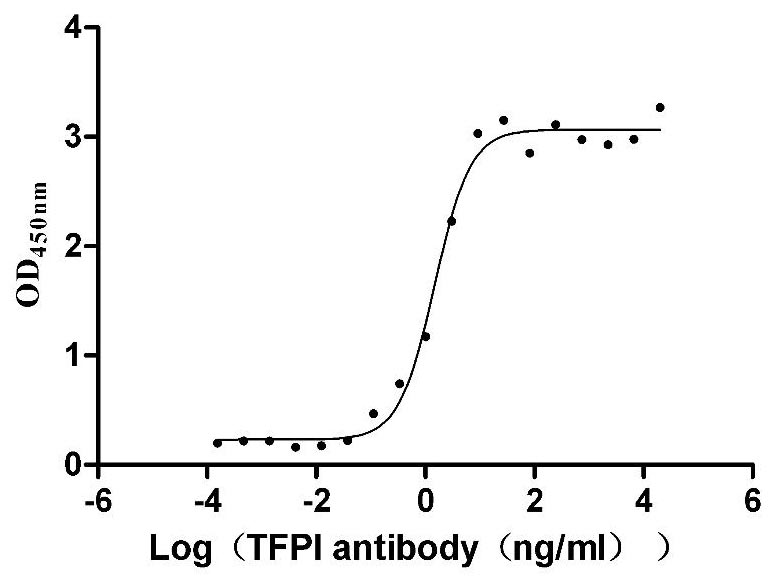
-AC1.jpg)
